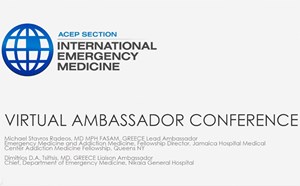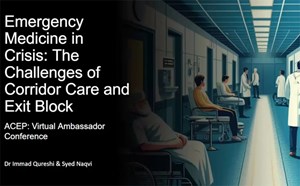innovatED! Fostering Low-Cost & Low-Tech Innovation in Global Emergency Medicine
Watch this International EM Section Virtual Ambassador Conference webinar covering emergency medicine in Pakistan. Dr. Asad Mian presents.
Read the Full Transcript
- My name is Asad Mian. I am a professor for Emergency Medicine at the Aga Khan University in Karachi, and my presentation is on innovated, next please, which fosters low cost and low tech ICE: innovation, creativity and entrepreneurship in global emergency medicine. So ICE is the acronym I will use for this presentation and it's not referring to any other kind of ice. Next slide please. I wish I had some companies to disclose, but I do not. Next. Okay, so this article came out in the Time about a year ago, and it was by Dr. Pensa who was in the EM position in the US and she is lamenting about boarding in EDS in the US and I was thinking while I was training and practicing in the US this was an issue that I felt, but I've been practicing in Pakistan for the past 10 years and this is a global phenomenon. Next please. So this brings me to the outline. What I want to get across is start local, talk about Pakistan a bit, but as we've heard already in this video conference, that EM is a, the global burden of EM, and so I will make the point or justification or rational, very clear for low cost and relatively low tech I should say, or low fidelity ICE for global EM. I will talk about the innovative model that we put together and we prototype tested and I put it upon it multiple times and perhaps at this time I can get into some challenges and future directions. Thank you. Next, sorry. Please, thanks. Alright, so here's Pakistan. For those of you who don't know where it's located, it's nestled between India, Iran, Afghanistan, China in the north, and then a bit of Central Asia. So next please. We are a low middle income country, so as an LMIC, we are very high in neonatal under one and under five modalities. We are also very high in maternal mortality. Next, it is very nice pregnancy and childbirth very because of death we do suffer from the triple well. There's a huge surgical inequity and disparity, a huge divide between rural and urban parts of the country and the triple burden of predictable noncommunicable and trauma related issues. Next, please. So if we look at the distribution between emergent versus non-emergent, so for LMICS it's about 60%. Next. So 60% is is for emergent and around 40% for non-emergent, which is kind of flipped for high income nations where 40% is emergent. But if you look at this from a global perspective it's about 50 50, right? So emergent disease become a huge issue anyways, hence a reason now for us to work in this area. Next, please. If you just look at this graph. So it's global head expenditure and I'm comparing the US to Pakistan. Might not be a very valid comparison, but if you just humor me for now, good. In the green line, you can see that Pakistan's global health expenditure has been pretty flat over a 15 year period from 2005 to 2020. But on the other hand, US is kind of exponentially going higher. And so it's not good for either place. Whether your global health expenditure going through the roof is not good, neither is no growth. So I will use that as a justification as to why there needs to be a shift, some change. And hence innovation, creativity, and entrepreneurship or ICE might be the good reason as to why we should be getting these things, next. So what is the problem with the pain point or the problem statement of ours? So there's a critical gap that exists between traditional EM practice and the escalating demand of modern emergency healthcare. Coupled with that is this absence of a comprehensive EM framework, which is designed centric, and by that I mean human-centered design. I don't have time to get into details, but there's also not enough innovation, creativity and entrepreneurship or ice, all of these things have been shown to enhance patient care, optimize processes and outcomes. Next. So the solution of our is a model which is, next, yes, so innovative is a model or a system that strategically is trying to bridge that gap. It encourages EM folks to think and act outside of the box, AKA innovation, creativity and entrepreneurship. And like I mentioned, because it's that gap, our model is rooted in principles of ICE. It's fueled by empathy driven design and it's a roadmap to where the innovation can thrive. Next, please. So you can just hit next, please, so innovation it's with the, the focus is ICE for emergency medicine. What's surrounding this, next, are the stakeholders, which are students and residents, fellows and faculty, nursing and adult health and admin and staff as well. We're working within EDS or departments of emergency medicine, next please. Surrounding all of that is the bricks and mortar structure, which supports ICE and that includes EM ideation and innovation hubs, maker spaces, incubators and accelerators and so on. Next, surrounding all of this is this mindset for academic medical centers, which is promoting ICE and a mindset change and IDEA stands for innovation and discovery for emergent and acute care sciences. Next, I know I don't have time to go get into this, but the red boxes over here indicate several of our case studies. Next, please. I'll get into some of them just to show you some examples, but before that, what's our secret sauce? So we work through rapid prototypic testing and iteration of these processes and it's called Jugaar Innovation. Jugaar is pretty. It's well known in in South Asia. Next, please. Some of the characteristics are given at this table seeking opportunity and adversity, doing more with less, thinking and acting flexibly and keeping it very simple. So faster frugal innovation frameworks, in other words. And so we've utilized Jugaar innovation for all of our processes. Next please. And so over here it's shown as a hub and smoke, hub and spoke model, innovative being at the center and it's powering all of these spokes. Eight examples are given over here. Next, I'm not gonna go through each but an OP board is really interesting to us because it helps you benchmark your ED's ICE potential, next, and we've come up with this baseline measurement of ICE potential and through that same process it's a phased approach and it can also enhance that baseline. Next, please. We published our data on this for, this is one example and this paper was for a particular emergency department in which just on the y axis, which you can see is taking calculated risks and being entrepreneurial through a self-assessment. And when you start distinguishing between different individuals within the emergency department, you could have a targeted approach as to which group of people or group of individuals you can work further on and enhance their innovation skillset. And we have a lot of data points around this and we can pick up that application you're interested. Next. We work with a lot of students, residents, nurses and so on through hackathons. This was an example of children's tower design or pediatric emergency medicine. Next, the first hackathon of ours was on emergency medicine and of emergency medicine picked up that story of ours. Next, please. And so through a lot of these kinds of events, we promoted the development of apps and devices. A few of them are shown over here and these are, these are medical and nursing students who put together these innovations. Next, please. This is one of the best examples that I can tell you the pain point over here is if we're neonatal, the baby gets intubated, the mother is given the ambu bag. This happens in thousands of hospitals over here because there's not enough folks who can manually bag the individual, the even let alone having a ventilator, so next please. So in the first in one of our hackathons, a team of students, next, prototype this was rapid prototyping over a weekend in a hackathon med students which, and other kinds of students, including some engineers as well. And this idea was picked up by an innovation lab, next please. And then they prototype in the lab. And then this has been patented both in the US and in Pakistan and in clinical trial. So you can go from a hackathon to an actual prototype that can be tested and tried and so on. Next please. This is from ASAP international publication that in which we've utilized human centered design thinking in the emergency department and using process innovation frameworks to improve throughput. Next. There there are various challenges, but the most important one is that you can just list it over here, that academic places, next please they tend to focus more on traditional currency, which is research grants, publications. So these kinds of novel events might be bit too novel for places, but it's a lot of fun. Next, please. What this points towards is, next, that you've got to build your ecosystem or culture of innovation, which we've been doing for several years. Next. The definite strengths and opportunities of the innovated model. There's a lot of multidisciplinary collaboration, it's very icentric and there's a lot of research potential as we demonstrated. There's a lot of diversity, equity and inclusion, inclusivity in these models. It's humanistic, it's wellness and that being oriented and the Jugaar innovation that I mentioned earlier. So you don't have to wait for tons of funding or enough team members before you can do any of these things. Next, please. So this paper, this article was, it's a few years old and it was talking about why innovation isn't helping reduce healthcare costs the US, next. So the what the article makes the point about is recommendations to promote opportunities for low cost innovation and process based innovation versus device or content based innovation is what's being encouraged and that's another way of doing Jagaar innovation or faster through innovation. So innovation is already working along those lines. Next. I think I'm almost done. Oh well, EPIs is EPI stands for exploration, preparation, implementation and sustainment. So this is an innovation management framework and innovated, we managed to actually to kind of super impose it onto the EPIS innovation management framework and its justification or endorsement of the work that we are doing so that pre existing innovation frameworks can be utilized and innovated something that's very denoval. The texture can be then built up further using something like FS, next. There's potential to take a lot of these ideas to market and potential multiple revenue streams, scale potential and so on. Next. So that's entrepreneurs by the way. Yeah, this is what I showed you earlier and if you keep hitting next, these are some of the examples that we, some of the same examples that we've incubated in-house. So innovation, benchmarking, emergency throughput, so on and so forth. This is examples of how we kind of incubated all those ideas and that's it I guess, next is just like conclusion, no SDGs. So all of these ideas actually are incorporating the sustainable development goals, next please, and that's it. So this could be an impactful model for our global EM. It's not only ICE it's also research and ultimately it's just helping people become better problem solvers and solution seekers with low-cost models. Thank you very much. I think skip the rest. We'll just thank it later. References. The team, picture of the team and if anybody's interested, please feel free to get in touch. Thank you.



